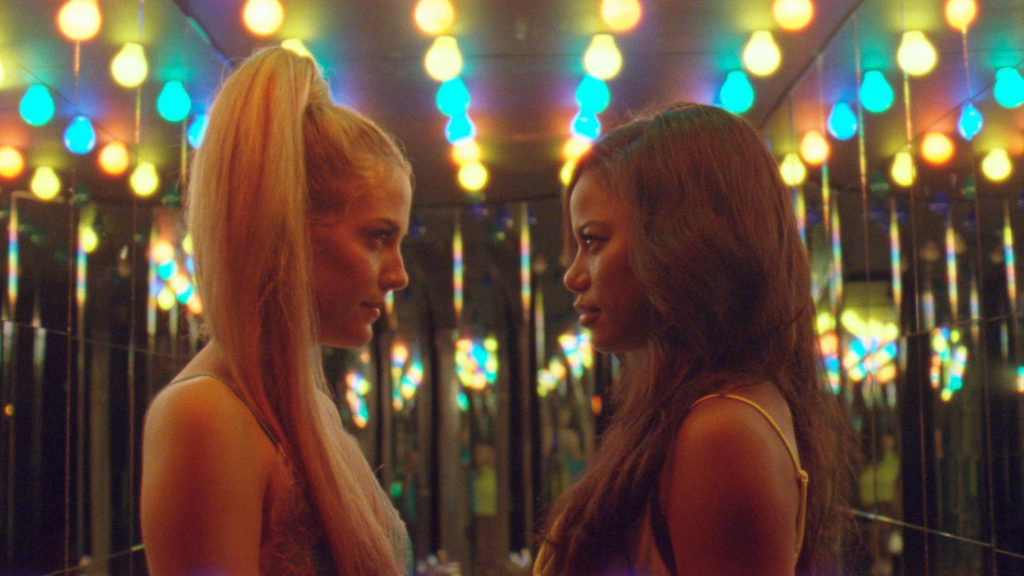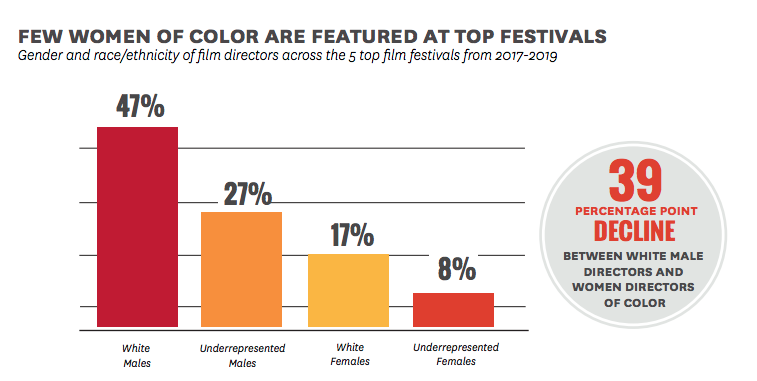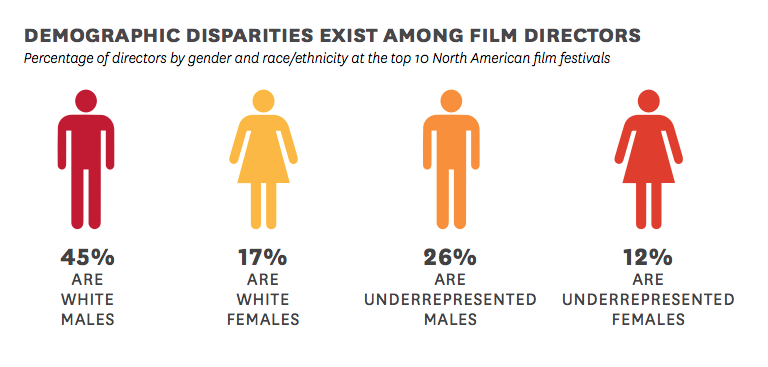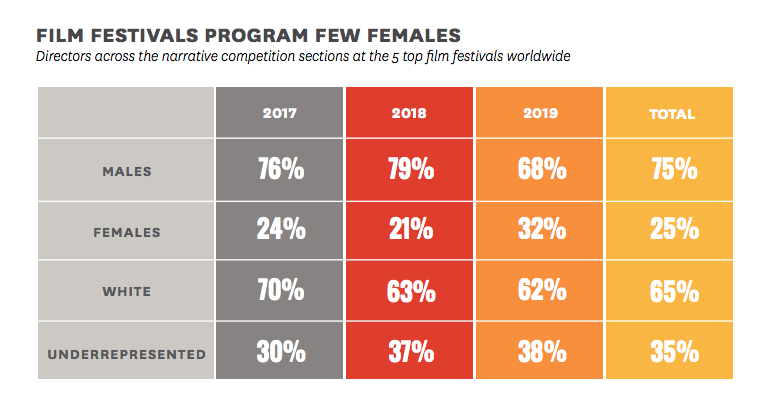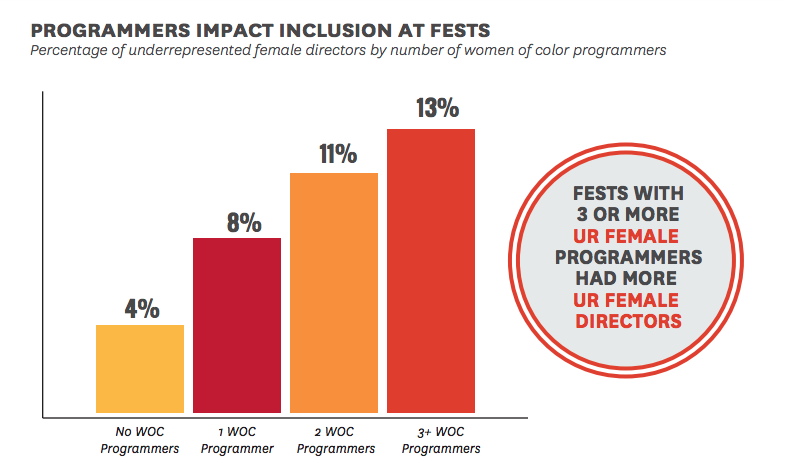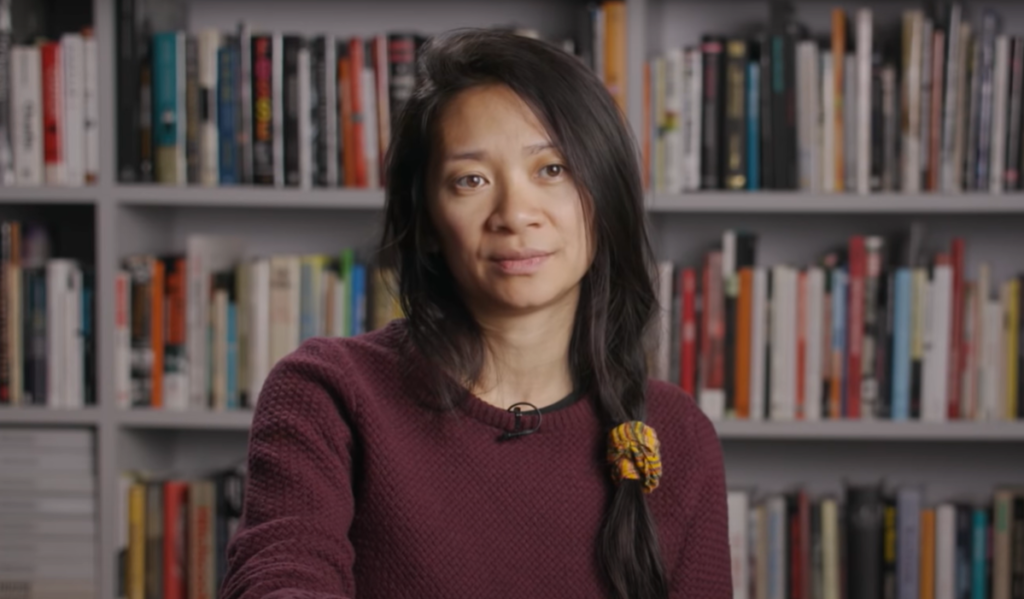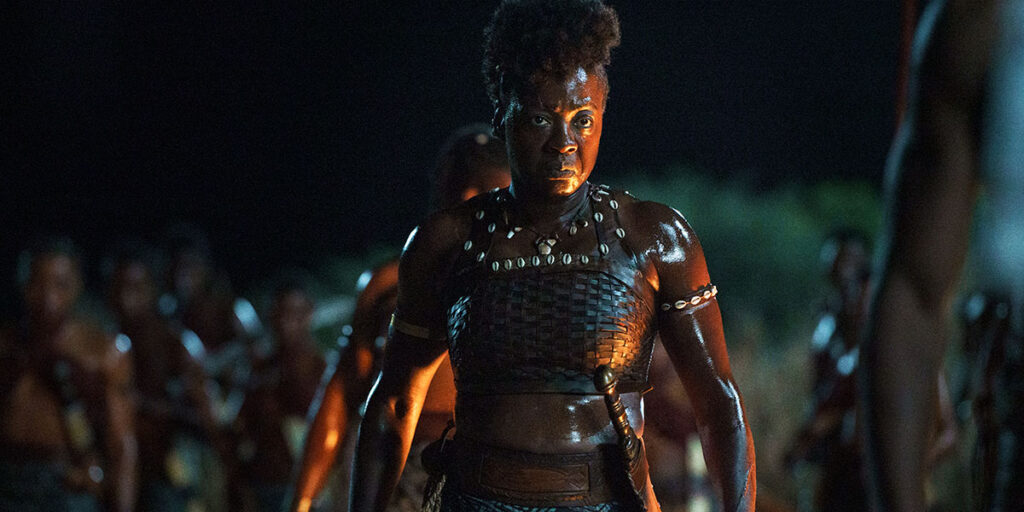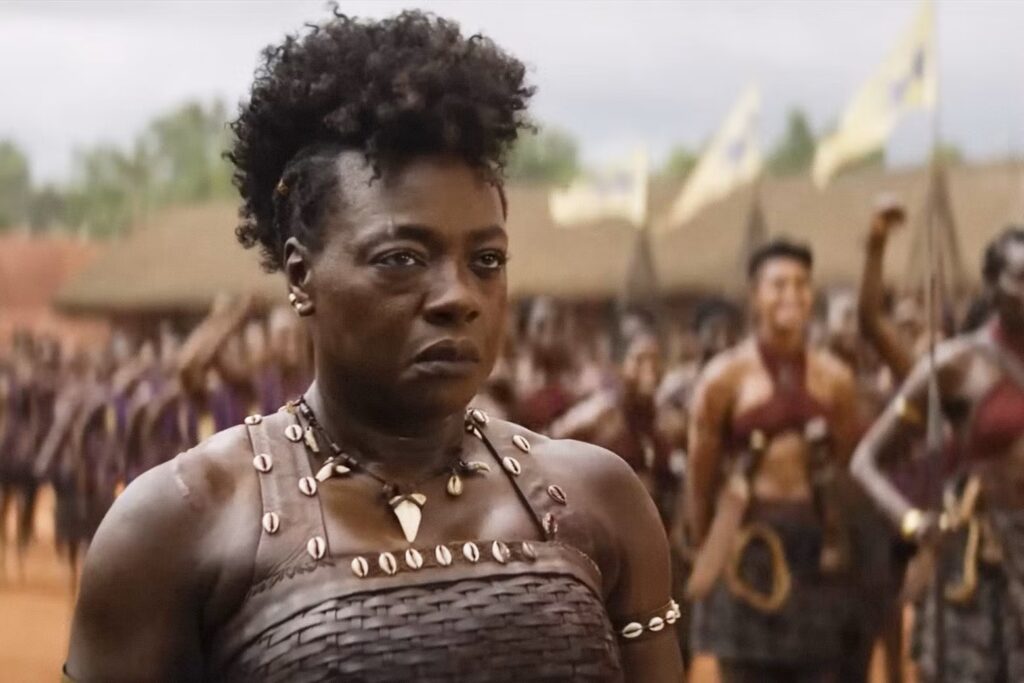We’re smack dab in the middle of the 2020 Sundance Film Festival, where 46 percent of competition directors are women and 38 percent are people of color. Given that Sundance is ongoing and that other renowned fests such as Berlinale, Tribeca, SXSW, and Cannes will soon be gearing up, now is a great time to take stock of how inclusive — or not — film festivals have become. In partnership with Time’s Up, the USC Annenberg Inclusion Initiative has released a new research brief, “Inclusion at Film Festivals: Examining the Gender and Race/Ethnicity of Narrative Directors from 2017-2019.” The gist of the research will be familiar with anyone who keeps track of diversity and representation trends in pop culture: there has been significant progress, but much work still needs to be done if film festivals are to be truly inclusive.
The brief, which considers the lineups and programmers of five global and 10 North American film festivals from 2017-2019, concludes that “2019 was a banner year for female filmmakers and other underrepresented directors.” But those recent strides still stop short of equality. “Despite the important progress underway, the study reinforces an all-too-common pattern: women and people of color are vastly underrepresented at film festivals worldwide, which are often the point of entry to the industry for emerging filmmakers,” a press release notes.
Across the global fests considered (Berlinale, Cannes, Sundance, TIFF, and Venice), only 25 percent of competition directors were women. Seventeen percent were white women and just eight percent were women of color. White men continue to dominate: they made up 47 percent of competition directors. It’s a similar story with the 10 North American festivals considered (Sundance, TIFF, New York Film Festival, SXSW, Telluride, Tribeca, Palm Springs, Santa Barbara International Film Festival, Seattle International Film Festival, and Slamdance): 29 percent of directors were women — 17 percent white women and 12 percent women of color. Meanwhile, white men represented 45 percent of directors.
“Despite the progress that is underway, the fact is that the voices and talent of women and people of color remain marginalized,” said Dr. Stacy L. Smith, founder of the USC Annenberg Inclusion Initiative. “The data in this report makes it clear that the next generation of women of color filmmakers are not being launched into the industry at the same rate as their white male peers.”
“Inclusion at Film Festivals” also examines the demographics of those overseeing and programming film festivals. Ten individuals run the five global film fests — three women and seven men. Just one is a person of color. In 2019, 47 percent of these festivals’ programmers or selection committees were women, and just 21 percent were people of color (14 percent women, and seven percent men).
The numbers are a bit better across the 10 North American fests. The top executives feature a 50-50 gender split, but are 85 percent white. Only one top exec is a woman of color. Meanwhile, women represent 44 percent of programmers, and people of color comprise 26 percent. “When these factors are crossed, the resulting statistics are as follows: white males 43%, white females 31%, underrepresented males 13%, underrepresented females 13%,” per the brief.
It’s important to note that when women of color are hired as programmers, more women directors of color screen their work at festivals, revealing “a linear relationship.” In festivals with zero women of color programmers, just four percent of festival directors are women of color. When at least three women of color serve as programmers, 13 percent of directors are women of color.
“Film festivals play a critical role in shaping our culture, which is why representation and access is so critical,” said Tina Tchen, president and CEO of Time’s Up Foundation. “While some festivals are taking the lead in featuring the voices of women and women of color, this study drives home the need to expand opportunities for women festival programmers — and, in so doing, women directors — of all backgrounds. We can do better.”
“As we have seen in our other collaborative work with Time’s Up, inclusion amongst those who evaluate content is essential,” Smith observed. “When film festivals are inclusive of women of color as programmers, there is a clear impact on the directors who get to participate. Festivals must ensure that their teams represent the audiences they hope to serve.”
Last week, Sundance, SXSW, Tribeca, TIFF, and more film festivals committed to setting aside a certain portion of their credentials for members of Time’s Up Critical, thereby ensuring more women, people of color, and other marginalized communities will attend as journalists.
Smith presented the “Inclusion at Film Festivals” research this past Friday at Sundance, during a panel discussion with “24-7” director and star Eva Longoria, “Professor Marston & the Wonder Women” filmmaker Angela Robinson, and the Sundance Institute’s Dilcia Barrera.
Key findings from study are below. Check out the full research brief here.
5 Global Film Festivals
Film Directors
- A total of 289 narrative competition movies were programmed across the 5 top films festivals from 2017-2019 with 303 directors attached. Overall, a total of 25% of competition directors were women and 75% men. This calculated into a gender ratio of 2.9 males to every one female.
- 2019 was a three-year high for female directors of narrative films as the festivals (32% of directors were female) and 2018 was a three year low (21%). 2017 held an intermediate position between these two years (24%).
- Focusing on directors that were not white, 35% of helmers were from underrepresented racial/ethnic groups. Put differently, 65% of narrative competition directors were white. This is a ratio of 1.9 white directors to every 1 director of color. 2018 (37%) and 2019 (38%) featured more directors of color in the narrative line ups than 2017 (30%).
- The crossing of gender and underrepresented racial/ethnic status revealed an all too common story. Nearly half (47%) of all narrative competition directors were white males followed by 27% who were underrepresented males. White female directors were roughly a sixth of all helmers (17%) and women of color were only 8%.
- Films were also coded for their country of origin (U.S. vs. International). Country of origin did not illuminate differences in female directors’ opportunities at Festivals (US=23% female. International=26% female).
- In terms of underrepresented filmmakers, the percentage of international films with UR directors (39%) was substantially higher than the percentage of U.S. films with UR directors attached (25%). Both 2018 and 2019 were significantly better than 2017 years for programming international films with underrepresented directors.
- Films’ country of origin was only related to male directors. White male directors were more likely to be programmed with U.S. films (60% of directors) than international films (42% of directors). The exact opposite trend was observed for underrepresented male directors (U.S.=17% of directors; Int=32% of directors).
Executives & Programmers
- We assessed the gender and underrepresented status of the festivals’ top executives (e.g., president, head, director/artistic director). The five festivals were run by 10 individuals, 7 males and 3 females. Put differently, 30% of the individuals at the top of these notable cultural institutions were women and 70% were men. Only 1 of the 10 executives were from an underrepresented racial group (10%).
- Turning to top programmers or selection committees, a full 47% were female and 53% were male as of 2019 across the 5 top film festivals (Berlin, Cannes, Sundance, Toronto, Venice). Only 21% of programmers were from underrepresented racial/ethnic groups across these prestigious distribution platforms. Overall, only 7% of programmers were men of color and 14% were women of color.
10 North American Film Festivals
Film Directors
- In terms of gender, 71% of directors were male and 29% were female. This is gender ratio of 2.5 males to every 1 female (see Table 8). A significant increase or 6 percentage point gain was observed from 2017 (25%) to 2019 (31%).
- In terms of underrepresented status, a full 62% of directors at the North American festivals were white and 38% were underrepresented. This latter statistic is close to U.S. Census, which is 39.6%. There was a significant increase in underrepresented directors over time. 2019 had a higher percentage of underrepresented directors (40%) than did 2017 (35%).
- Overall, nearly half of all directors (45%) at the 10 top festivals in North America were white men, 26% were underrepresented men, 17% were white women, and 12% were women of color.
- In terms of change over time, the percentage of white male directors has decreased 7 percentage points from 2017 (49%) to 2019 (42%). Yet, a concomitant significant increase was not observed for underrepresented male directors, white female directors, or 3 underrepresented female directors. Given that U.S. population statistics are 30% white males, 30% white females, 20% underrepresented males, and 20% underrepresented females, the findings reveal that these film festivals are overserving stories by Caucasian men and grossly underserving stories by white women and women of color.
- In terms of gender, the three top North American film festivals for female directors of narrative features across 3 years were Tribeca (35% female directors), Sundance (34% female directors), and SXSW (33% female directors). All of the other festivals had percentages below these top three. The top three festivals for women of color directors were as follows: Toronto (14% WOC directors), Seattle (14% WOC directors), and Palm Springs (13% WOC directors). Again, all of the other festivals programmed at a lower percentage than the top 3.
Executives & Programmers
- Across the 10 festivals, 50% of the top executives were males and 50% were females. These were Executive Directors, Directors of Programming, and Artistic Directors running the film festivals.
- Focusing on race/ethnicity, 85% were white and 15% were underrepresented. Only one top executive was a woman of color.
- Of 236 individual programmers, 74% were Caucasian and 26% were from underrepresented racial/ethnic groups. Forty-four percent of programming teams were comprised of women. When these factors are crossed, the resulting statistics are as follows: white males 43%, white females 31%, underrepresented males 13%, underrepresented females 13%.
Relationship between WOC Programmers & WOC Directors
- We categorized each festival as having none, one, two, or three or more women of color as programmers. Then, we examined the percentage of WOC directors across all 13 festivals and 3 years of programming decisions. A linear relationship emerged. The percentage of women of color directors increased as women of color programmers increased. When no women of color worked as programmers, 4% of directors were women of color. When three or more women of color were programmers, 13% of directors were women of color.
